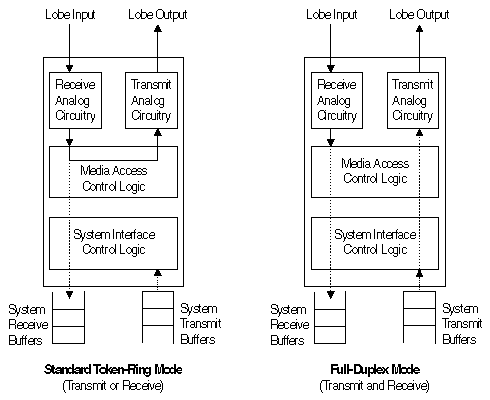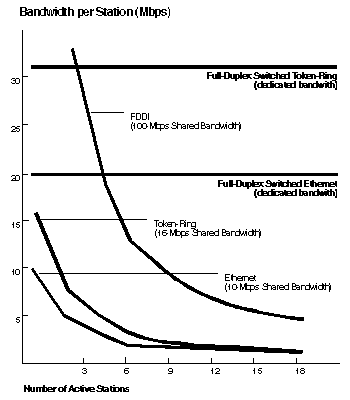|
Adapter Support
Full-Duplex Operation
Sources:
Token-Ring Adapter FDX Drivers/Microcode ("Adapter Support" - archived)
Token-ring migration to switched LAN interconnect ("FDX Operation" - 1997, archived)
Adapter Support
Token Ring Adapters
Auto 16/4 MC - Unknown (Early pages say 1997, then "Contact IBM for more information")
10H4710
50G7028 Token Ring front end LANStreamer MC 16 - No FDX
50G8180 Token Ring protocol chip "Huntingdale"
National Semiconductor 93F2932 Token Ring front end LANStreamer MC 32 - No FDX
50G8180 Token Ring protocol chip "Huntingdale"
National Semiconductor 93F2932 Token Ring front end Auto LANStreamer MC 32 - FDX Capable
73G2692 or 38H6302 Multi-Protocol Chip (MPC)
50G7028 Token Ring front end Dual LANStreamer MC 32 - FDX Capable
73G2692 Multi-Protocol Chip (MPC)
50G7028 Token Ring front end
Ethernet Adapters
EtherStreamer MC 32 - FDX Capable
60G0663 or 73G2692 Multi-Protocol Chip (MPC)
National Semiconductor DPADP10 Ethernet front end Dual EtherStreamer MC 32 - FDX Capable
73G2692 Multi-Protocol Chip (MPC)
National Semiconductor DPADP10 Ethernet front end
Full-Duplex Operation
The classical operation mode of Ethernet and Token Ring is referred to as
half-duplex (HDX) here, meaning that a station can either transmit or receive
data but not both simultaneously. Also, in the shared LANs, only one station
can transmit at a time. A server with a single network interface connection
(NIC) is limited to the amount of bandwidth that it can acquire in a
shared-network environment as network loading increases. Priority access
schemes in both Token Ring and FDDI systems can reduce access delays for
selected stations, thus making them well suited for many types of multimedia
applications.
FDX is a well-known mode of operation in communication networks. However, it
is only with recent advances in switching technology that it is now practical
to consider switching and FDX operation at speeds of 10, 16, or even 100 Mbps.
In FDX operation, separate transmit and receive paths are dedicated on a
point-to-point link rather than repeating the incoming data signals (See Figure
1).

Figure 1: Full-Duplex Adapter Operation (Reference 3)
There are no collisions or tokens to regulate media access, because
dedicated transmit and receive paths exist. Each station simply transmits data
once it has been correctly formatted within the adapter. This greatly
simplifies the MAC protocol (Reference 1). The switch and adapter designs
ensure that there are adequate buffers to receive the incoming frames. Data
loss can occur during periods of bursty traffic if inadequate buffer capacity
is provided (Reference 2). Some limited flow-control schemes were designed for
the connection-oriented link-level protocols for relieving congestion in
intermediate bridges and are also applicable to switched environments. The best
example is the dynamic-window algorithm defined for IEEE 802.2 Type 2
(connection-oriented) service (Reference 3).

Figure 2: Dedicated FDX vs Shared-Bandwidth Performance
The most compelling reason to migrate to FDX operation and a switched
environment is the significant gain in bandwidth that is available to each
individual station (References 1 and 3). With shared networks, such as token
ring and Ethernet, the amount of bandwidth available to each station decreases
in proportion to the number of stations that share the link (See Figure 2).
This has been sufficient for the past 10 years due to the limited bandwidth
requirements of existing applications. However, emerging multimedia
applications could require as much as 4 to 6 Mbps per session. This bandwidth
can be provided by simply dedicating to each station the full bandwidth of the
LAN adapter. However, once the link has been dedicated to one station, FDX
operation then essentially doubles the available bandwidth while also
decreasing end-to-end latency.
References
- Saunders, S., "Traffic Jam at the LAN Switch," Data Communications, 21
November 1994, 53-58.
- Bux, W. and Grillo, D., "Flow Control in LANs of Interconnected Token
Rings," IEEE Transactions on Communications, COM-33 (October 1985),
1058-1066.
- Tolly, K., "Token Ring Switching: The Design Challenge," Data
Communications, February 1995, 97-104.
|